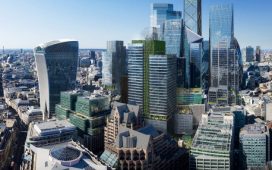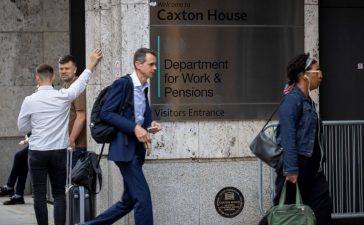Stay informed with free updates
Simply sign up to the UK property myFT Digest — delivered directly to your inbox.
In London’s Mayfair, the lofty neoclassical staircase of 66 Grosvenor Street has been freshly painted a sophisticated grey. The lick of paint has more to it than just a modern colour palette.
The experimental paint job also embeds compounds designed to attract and break down pollutants in the air, explained Andy Creamer, who has overseen a recent overhaul of the building to bring the 300-year-old Georgian town house, now used as offices, up to modern energy efficiency standards.
Creamer is responsible for an ongoing £90mn environmental retrofit project across the 300-acre historic London estate of Grosvenor, the Duke of Westminster’s property company, which is due to overhaul 1mn sq ft of space by the end of the year.
The daunting scale of the project — which has involved ripping out 50 gas boilers, and installing more than 2,000 sensors to monitor temperature and air flow to make heating and ventilation more efficient — attests to the huge challenge facing UK landlords to bring Britain’s old and draughty building stock up to modern standards.
The project is a forerunner of the difficulties many other commercial landlords and homeowners will ultimately have to face if the UK is going to meet its climate goals.
“It’s very easy to convince yourself that now is not the right time,” Creamer said, a brisk, cheerful man with more than a decade’s experience at Grosvenor. “We can’t wait 10 years.”
The government recently walked back proposed 2025 deadlines for residential landlords to improve energy efficiency, but commercial property owners face tougher timelines.
Three-quarters of commercial floorspace in England is rated EPC C or lower, according to the think-tank Centre for Cities, meaning it would need to be upgraded by 2030 if the government pushes ahead with current proposed regulations.

The UK Green Building Council, an industry group, said that energy consumption from commercial property sectors such as offices would need to fall 59 per cent to achieve net zero by 2050. The group in December said the UK was “significantly” behind the progress needed on reducing building emissions.
Uncertainty over those regulations has led some landlords to delay. “We are advising clients to spend sometimes in the region of millions of pounds to upgrade their buildings,” said Ollie Morris, director of sustainability at real estate firm CBRE. “And the justified comeback is ‘do we actually need to do this?’’’
Some gains can be achieved by simply running buildings more efficiently. Mike Edwards, director at engineering firm Arup, said some owners could achieve 15 to 20 per cent energy savings by “tuning the building like you would tune a car”.
But ultimately, particularly leaky older buildings will need upgrades. Some owners are moving ahead of the government requirements to avoid being left behind.
Grosvenor’s decision to spend on big retrofits ahead of the deadlines reflects its advantages as a large, private landlord with deep pockets.
For other owners facing a huge rise in the cost of debt and a lack of demand for many older offices as people shift to working from home, financial survival is higher on the priority list than green projects.
The practical difficulties are also daunting, particularly in historic properties that make up vast swaths of UK towns and cities. “As a landlord with a single property or two properties, it’s horrendous,” Creamer said.
About 600,000 commercial properties in the UK are historic buildings dating from before 1919, according to research by Grosvenor.

High on the list of challenges to refitting these properties is finding enough skilled workers. About 100,000 people work on historical buildings in the UK, according to research by consultancy Capital Economics.
That workforce would need to double to complete necessary retrofit work by 2050, with particularly intense demand for electricians and heating and ventilation installers. The research suggests the gap in the workforce will bite as retrofit work ramps up in the 2030s unless the government and industry invest in building the workforce.
Supply chains have also been strained by the increase in demand for green technology in buildings. “Lead times are awful for air source heat pumps in particular,” said Creamer, who added that he can wait up to three months for new heat pump orders.
The UK’s planning system and heritage protections can add painful delays. Grosvenor looks after 500 Grade I and II listed buildings and structures.
Creamer said that in one row of 15 historic town houses in Buckingham Palace Road, the company applied for permission to install heat pumps, new glazing and solar roof tiles. The nearly identical applications were approved on 14 of the 15 buildings, but refused on the last one because a different planner had worked on that file.
He praised local authorities such as the City of Westminster, which has formed a retrofit task force to speed up approvals. Nearly 80 per cent of the city is covered by a conservation area. But, he said: “The retention of heritage has often taken precedence over future-proofing the properties.”









